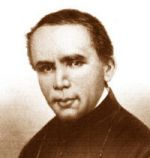St. Rita of Cascia
by Rev. Vincent F. Kienberger, O.P.
St. Rita of Cascia is the patroness of desperate cases. Her aged parents were Antonio Lotti and Amata Ferri Lotti [editor’s note: The author gave the last name as “Mancini”, which was actually the last name of Rita’s husband, so we have corrected this to “Lotti”.], two hard-working peasants of Rocca Porena, a hamlet in the commune of Cascia in Umbria. They had been married fifty-three years when Rita was born. This event in their advanced age helps one to believe in the legend that an angel appeared to Amata and told her: "You shall have a daughter and you shall call her Margherita." The good lady, relying solely on divine Providence, did not complain: "If it's God's will, I would prefer a boy, so that he could grow up and care for this farm and for Antonio and for me when we can work no longer."
The angel's prophecy was fulfilled and a girl was born to Amata and Antonio, May 22, 1381. The parents called this miraculous flower, which blossomed in the winter of their lives, Margherita—"the pearl." The old folks grew young again with the joy that had once been in the hearts of Sts. Joachim and Anne.
As soon as Margherita could walk, she toddled off with her father to the fields. She was able to pronounce the names of the domestic animals, the names of the tools, the names of the trees and of the various fruits. Once in a while the little girl went with her mother to the mountains to pick berries or to gather herbs.
The parents could not read, but they knew their prayers, the catechism and the Sunday Gospel. They meditated on the Scriptures, and the Gospel stories were engraved upon their untutored minds.
From her devoted parents Rita soon learned her prayers by heart; she gradually came to know her catechism and the truths of her holy religion. Like Sts. Zachary and Elizabeth, Antonio and Amata taught by example. Both couples were "just before God, walking blamelessly in all the commandments and ordinances of the Lord" (Luke 1: 6). Rita learned charity toward persecuted folk from her parents. They loved their neighbors as the Master had commanded.
It was Rita's desire to be a nun. Out of deference to her parent's wishes, however, she agreed to marry a youth selected by her parents. This man turned out to be a brute, and once was accused of murder. His wife's heroic patience caused grace to flow into his soul, and he finally repented. Yet his enemies murdered him. His two sons sought revenge, but contracted a fatal fever which gave them time to repent.
Now all alone in the world, Rita entered the convent of the Augustinian nuns where she died in sanctity, May 22, 1457, having fulfilled the vocations of daughter, wife, mother, widow, and nun. On May 24, 1900, Pope Leo XIII canonized St. Rita, heralding her as the saint of impossible and desperate cases. St. Rita's Church at Cascia was raised to the ranks of a basilica, September 11, 1955, by Pope Pius XII. Her tomb contains her incorrupt body where numerous miracles have been wrought since her death. The Saint's prayers have aided countless youths in choosing a vocation which they never would have dreamed humanly possible to achieve.
This item 6115 digitally provided courtesy of CatholicCulture.org






